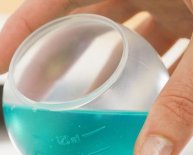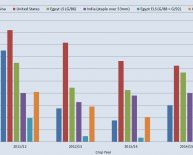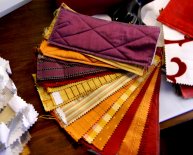
Cotton characteristics and properties
Cotton is often called the king of fibers because of it's wide array of uses and popularity around the world. Currently it accounts for more than 50 percent of all fibers used for apparel and home furnishings in the US. The earliest evidence of cotton fabrics in use dates back to 3000 BC in India and South America. Cotton cultivation then spead to Egypt, China and the South Pacific.
Cotton is a soft, staple fiber that grows in a form known as a boll around the seeds of the cotton plant, a shrub native to tropical and subtropical regions around the world, including the Americas, India and Africa. The fiber most often is spun into yarn or thread and used to make a soft, breathable textile, which is the most widely used natural-fiber cloth in clothing today. The English name derives from the Arabic (al) qutn قُطْن, which began to be used circa 1400.
Each cotton fiber is composed of concentric layers. The cuticle layer on the fiber itself is separable from the fiber and consists of wax and pectin materials.
Cotton is a soft fibre that grows around the seeds of the cotton plant. Cotton fibre grows in the seed pod or boll of the cotton plant. Each fibre is a single elongated cell that is flat twisted and ribbon like with a wide inner hollow (lumen).
- 90% cellulose, 6% moisture and the remainder fats and impurities
- The outer surface is covered with a protective wax like coating which gives fibre an adhesive quality
Cotton is a natural fiber that is grown in countries around the world. It is a crop that requires adequate moisture and heat to mature and produce quality fibers. Cotton growing tends to be in warmer climates. Cotton is a true commodity in the world markets and supply and demand truly affect prices of raw cotton.
Properties of Cotton Products
- Comfortable – there are no surface characteristics of cotton that make it irritating to human skin. Cotton feels good against skin; it has a soft hand.
- Hydrophilic – cotton has a natural affinity for water – it attracts moisture away from your body.
- Moisture passes freely through cotton – aiding in evaporation and cooling
- Good Heat Conductivity – Cotton allows heat to dissipate making it a wonderful fiber to maintain a comfortable sleeping temperature.
- Strong and abrasion resistance
- The unfavorable attributes of cotton include its lack of resiliency (cotton tends to wrinkle) and its lack of luster (colors are usually dull).

















